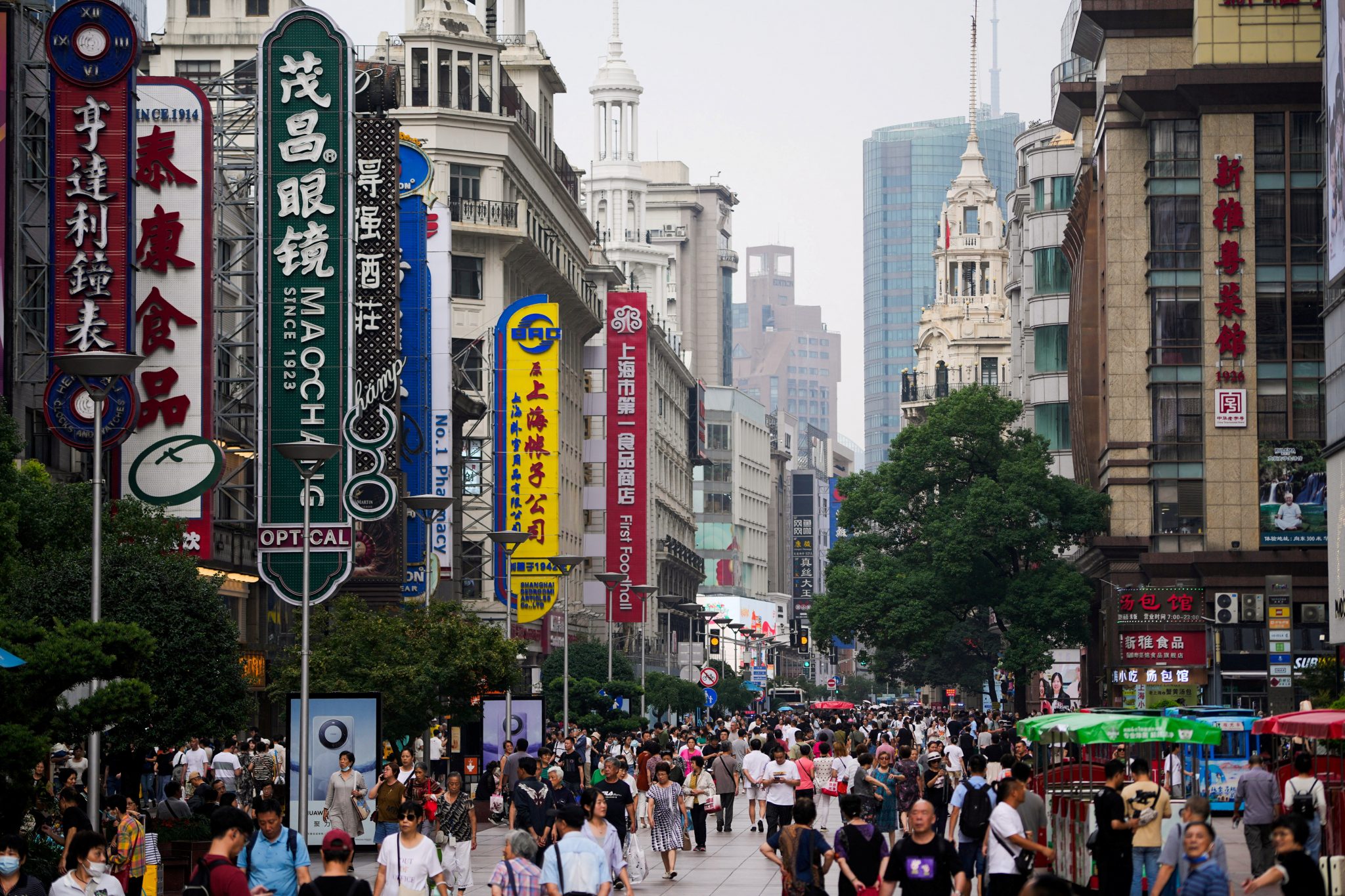China’s Economic Engine Sputters: Slowing Growth Raises Concerns for the Dragon
China’s once-roaring economy is showing signs of fatigue. In 2023, its GDP growth rate clocked in at 5.2%, the weakest since 1999 (excluding pandemic years). This concerning trend continues in 2024, with analysts predicting even lower growth figures. What’s causing this slowdown, and what are the potential consequences?
Multiple factors are contributing to China’s economic deceleration:
- Demographic Shift: An aging population and declining birthrates are shrinking the workforce, impacting productivity and domestic demand.
- Property Market Woes: The once-booming property sector, a major driver of growth, is facing a crisis due to oversupply and tightened regulations. This has ripple effects on construction, investment, and consumer spending.
- Global Headwinds: The ongoing trade war with the US, a slowing global economy, and rising geopolitical tensions are dampening export demand and foreign investment.
- Zero-COVID Policy: While successful in containing the pandemic, China’s stringent zero-COVID approach has disrupted supply chains and economic activity.
The consequences of slower growth are multifaceted:
- Lower living standards: Slower economic growth translates to slower wage growth and potentially, stagnant or declining living standards for the average Chinese citizen.
- Increased unemployment: Slowing industries could lead to job losses, particularly in manufacturing and construction sectors.
- Social unrest: Economic hardship can breed social discontent and potential unrest, posing a challenge to social stability.
- Global impact: As the world’s second-largest economy, a slowdown in China has ripple effects on the global economy, impacting trade and investment flows.
The Chinese government is implementing various measures to address these challenges:
- Stimulus packages: Increased infrastructure spending and tax cuts aim to boost economic activity and investment.
- Easing property market regulations: Relaxing some restrictions on the property sector could revive the market and unlock investment.
- Promoting domestic consumption: Policies encouraging domestic spending could offset declining exports.
- Opening up the economy: Further integration with the global economy could attract foreign investment and boost trade.
The road ahead for China’s economy remains uncertain. The success of implemented measures and the evolution of external factors like the global trade landscape will determine how effectively China can navigate this slowdown. Continued monitoring of key economic indicators and policy developments will be crucial in understanding the trajectory of the Dragon’s economic engine.
Additional points to consider:
- The role of technological innovation in driving future growth.
- The impact of environmental sustainability efforts on the economy.
- Potential geopolitical ramifications of a slower-growing China.
By understanding the complex factors at play and the ongoing policy responses, we can gain a clearer picture of the challenges and opportunities that lie ahead for China’s economy.






eykkv4
December 31, 2024Hfpyrq
buy ivermectin 12 mg for humans – atacand cheap purchase tegretol sale
January 2, 2025drxgtv
January 5, 2025a8fpkb
January 8, 2025g77e0h
January 12, 2025Yyvahl
order accutane pills – linezolid 600 mg price order linezolid generic
January 14, 2025uuk138
January 14, 2025Lwrall
purchase amoxicillin – cheap amoxil sale combivent medication
January 15, 2025itrr9o
January 17, 20258sdpk4
January 26, 2025Zcmjyg
azithromycin 250mg for sale – purchase zithromax pill nebivolol 5mg over the counter
January 27, 20259ut7wm
January 27, 2025Nyipng
prednisolone 40mg over the counter – prometrium ca oral progesterone 200mg
January 30, 2025wukgzu
February 5, 2025Ynfddk
neurontin canada – generic anafranil order sporanox 100mg generic
February 7, 2025Uninpr
buy lasix 100mg pill – buy nootropil 800mg how to get betamethasone without a prescription
February 8, 2025Dizdvb
buy generic doxycycline for sale – generic glucotrol 10mg buy glucotrol pills
February 13, 2025Pvozim
order augmentin pill – amoxiclav over the counter cheap duloxetine 20mg
February 14, 20254z5mg3
February 19, 2025i03auj
February 20, 2025tlovertonet
Nice post. I learn something more challenging on different blogs everyday. It will always be stimulating to read content from other writers and practice a little something from their store. I’d prefer to use some with the content on my blog whether you don’t mind. Natually I’ll give you a link on your web blog. Thanks for sharing.
February 20, 2025disinformations
cmpUx23NbRV
February 21, 2025Fvwffv
cost augmentin 625mg – order cymbalta 20mg duloxetine price
February 21, 20255cbpyt
February 21, 2025Kpzrud
tizanidine 2mg over the counter – order generic plaquenil hydrochlorothiazide 25mg oral
February 26, 202506vwml
February 28, 2025Uuwzcd
buy tadalafil 20mg – tadalafil online buy order viagra 50mg generic
March 3, 2025Mxksbt
buy viagra 50mg online cheap – cheap generic sildenafil order cialis 40mg online
March 3, 2025r1g0jw
March 5, 2025ex810t
March 6, 2025lj8km5
March 6, 2025hsx86j
March 8, 2025ukkkug
March 11, 2025Snfzww
buy cenforce generic – order glycomet 1000mg generic order glycomet for sale
March 11, 2025vorbelutr ioperbir
Hey! Someone in my Facebook group shared this site with us so I came to check it out. I’m definitely loving the information. I’m bookmarking and will be tweeting this to my followers! Fantastic blog and fantastic design.
March 11, 2025rv6c50
March 12, 2025Jfhkpt
buy lipitor medication – buy zestril 10mg generic order zestril 2.5mg for sale
March 13, 2025Qztknh
buy omeprazole for sale – order lopressor 100mg sale cheap tenormin 100mg
March 20, 2025tlovertonet
you’re really a excellent webmaster. The website loading speed is incredible. It sort of feels that you’re doing any distinctive trick. Moreover, The contents are masterwork. you’ve done a fantastic process on this subject!
March 25, 2025Idtffd
depo-medrol for sale online – pregabalin order online cost aristocort 4mg
March 25, 2025Lxmapo
buy desloratadine for sale – order clarinex without prescription priligy brand
March 27, 2025Eigono
buy misoprostol sale – cost orlistat 60mg buy diltiazem pill
March 30, 2025drover sointeru
Hey, you used to write excellent, but the last few posts have been kinda boring?K I miss your tremendous writings. Past few posts are just a bit out of track! come on!
April 2, 2025Nqkvvc
buy zovirax 800mg online – buy zovirax pills for sale buy rosuvastatin 20mg online
April 4, 2025Msesqm
motilium 10mg drug – buy sumycin 500mg for sale cyclobenzaprine sale
April 7, 2025Zewphv
domperidone cost – tetracycline 250mg cheap purchase flexeril pill
April 14, 2025Shqayf
inderal brand – inderal 20mg without prescription methotrexate 2.5mg us
April 15, 2025Vtgoul
purchase warfarin for sale – buy warfarin generic buy losartan generic
April 19, 2025Qlgdwp
levofloxacin 250mg without prescription – ranitidine 300mg tablet ranitidine 150mg uk
April 22, 2025Gcbxda
purchase meloxicam generic – buy celebrex tablets tamsulosin over the counter
April 28, 2025Jsvxkz
order zofran 8mg online – order zocor pill buy zocor 20mg online cheap
May 15, 2025Abbcxt
brand valtrex – buy forcan medication order diflucan 100mg generic
May 16, 2025q73xy
buy modafinil generic buy provigil generic order modafinil 200mg for sale oral provigil provigil canada provigil pill buy modafinil pills for sale
May 31, 2025y7jc6
buy cheap clomid pill cheap clomid without insurance order generic clomiphene without insurance where to buy cheap clomid price order cheap clomid without dr prescription where to get generic clomid no prescription buy clomiphene without prescription
June 6, 2025buy generic cialis paypal
With thanks. Loads of erudition!
June 8, 2025cheap cialis canadian pharmacy
More posts like this would persuade the online time more useful.
June 9, 2025flagyl and ciprofloxacin
The thoroughness in this break down is noteworthy.
June 10, 2025